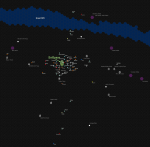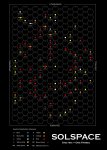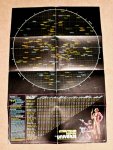I made this for myself, but I figured it might be of use to others who want to set sci-fi campaigns in real space.
Right, here we go. It's not super-pretty, but if you plan to use our actual galactic neighbourhood for a setting, this is a functional resource. So, notes:
- This map is real space, 500 parsecs across, and shows major interstellar objects (clusters, nebulae, etc.)
- Each hex is 10 parsecs, or 32.6 light years. They're big - as you can see, entire nebulas and star clusters fit easily into single hexes.
- At light speed it takes 32.6 years to cross one hex.
- The green area is the 30-light year SolSpace sector I use in WOIN.
- Each hex contains a dozen or more star systems. The scale is too large to show individual stars, but I've put a handful of well known bright stars on there. The SolSpace map itself contains lots of stars whose names you'd recognise, but the scale of this one is too large to show them.
- This is 50 hexes across; still only about 2% of the galaxy, which is 3000 hexes across.
I used Hexographer to do this. I'm no expert, but it's functional!

This is the SolSpace section zoomed in. You'll likely recognise lots of stars in this one. I've had this one for ages.

Right, here we go. It's not super-pretty, but if you plan to use our actual galactic neighbourhood for a setting, this is a functional resource. So, notes:
- This map is real space, 500 parsecs across, and shows major interstellar objects (clusters, nebulae, etc.)
- Each hex is 10 parsecs, or 32.6 light years. They're big - as you can see, entire nebulas and star clusters fit easily into single hexes.
- At light speed it takes 32.6 years to cross one hex.
- The green area is the 30-light year SolSpace sector I use in WOIN.
- Each hex contains a dozen or more star systems. The scale is too large to show individual stars, but I've put a handful of well known bright stars on there. The SolSpace map itself contains lots of stars whose names you'd recognise, but the scale of this one is too large to show them.
- This is 50 hexes across; still only about 2% of the galaxy, which is 3000 hexes across.
I used Hexographer to do this. I'm no expert, but it's functional!

This is the SolSpace section zoomed in. You'll likely recognise lots of stars in this one. I've had this one for ages.

SaveSave
[FONT="]Save[/FONT][FONT="]Save[/FONT]
[FONT="]Save[/FONT][FONT="]Save[/FONT]
Last edited:


